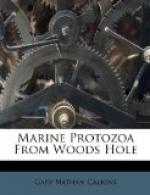Monas sp. Fig. 9.
An extremely small form (3 mu) attached by a thread of protoplasm—perhaps a flagellum, to algae. The body is ovoid and the main flagellum is about four times the length of the body. The contractile vacuole is posterior. Only one specimen was seen and upon this I shall not attempt to name the species.
[Illustration: Fig. 9.—Monas sp.]
Genus MONOSIGA Kent ’81.
(Buetschli ’86; France ’97; Senn 1900.)
Small colorless forms of Choanoflagellida, always naked and solitary. The posterior end is attached directly to the substratum, or there is a short stalk not exceeding the body in length. Kent ’81 distinguished nine species, but Buetschli questioned the accuracy of many of these, and in this he was followed by France ’97, who recognized three species—Monosiga ovata, M. fusiformis, and M. augustata. Fresh and salt water.
Monosiga ovata S. Kent ’81. Fig. 10.
Synonyms: M. brevipes S. K.; M. consociata
S. K.; M. limnobia
Stokes.
The individuals are unstalked or provided with a very short stalk less than the body in length. The form is spherical or ovate, broadest at the base and tapering to the extremity. The collar is somewhat variable in size. In the Woods Hole forms it was about the length of the body. Oil particles present. Contractile vacuole posterior, nucleus anterior.
Fresh and salt water. Length of body without the collar 5 mu.
[Illustration: Fig.10.—Monosiga ovata.]
Monosiga fusiformis S. K. Fig. 11.
Synonyms: M. steinii S. K.; M. longicollis S. K.
The individuals are unstalked, minute, and of a general flask-shape. The body is swollen centrally and tapers slightly at each end. There is no stalk, the body being fixed by the attenuate posterior end. There are two contractile vacuoles and one nucleus, which is situated a little above the body center. Fresh and salt water. Length without collar 9 mu; length of collar 3 mu.
[Illustration: Fig. 11.—M. fusiformis.]
Genus CODONOSIGA (Jas. Clark ’67).
(Buetschli ’78; Kent ’81; France ’97; Senn 1900.)
This genus, as modified by France, is distinguished from the preceding by the possession of an unbranched stalk much longer than the body length. The body is naked and of various shapes, and the individuals are solitary or colonial upon a single stalk. Kent ’81 enumerates no less than 10 species, which were cut down by Buetschli to 1. France admits 4—C. botrytis Jas. Clark; C. grossularia; C. pyriformis, and C. furcata, all S. Kent—but regards the second and third as merely form varieties of the first.
Codonosiga botrytis (Ehr. sp.) Jas. Clark ’67. Fig. 12.
France gives the following synonyms: Epistylia botrytis Ehr.; E. digitalis Stein, Zoothamnium parasitica Stein; Anthophysa solitaria Fresenius; Codonosiga pulcherrima Jas. Clark; Monosiga gracilis S. Kent; M. globulosa S. Kent; Codonosiga pyriformis Kent; C. grossularia Kent; (France).




